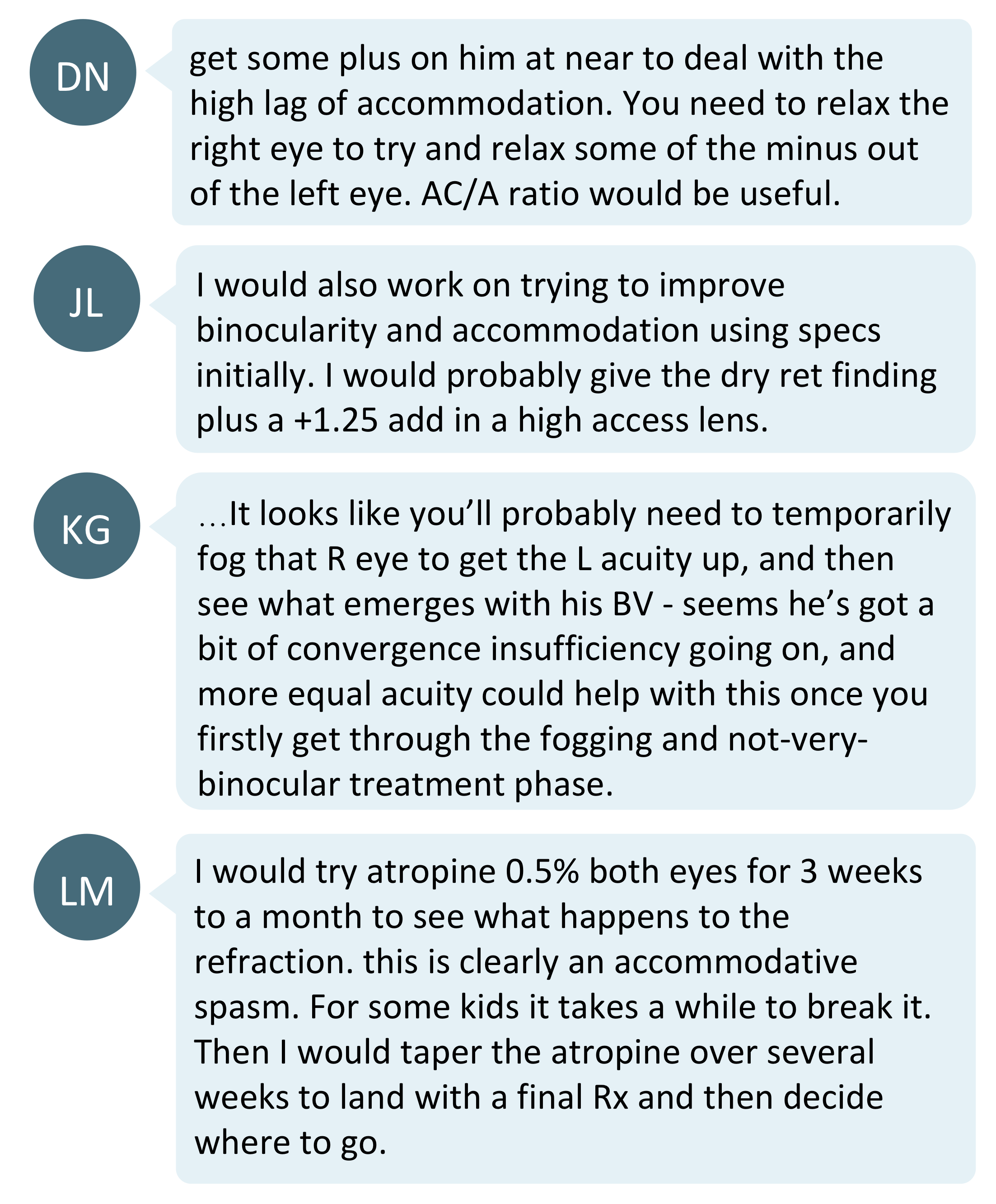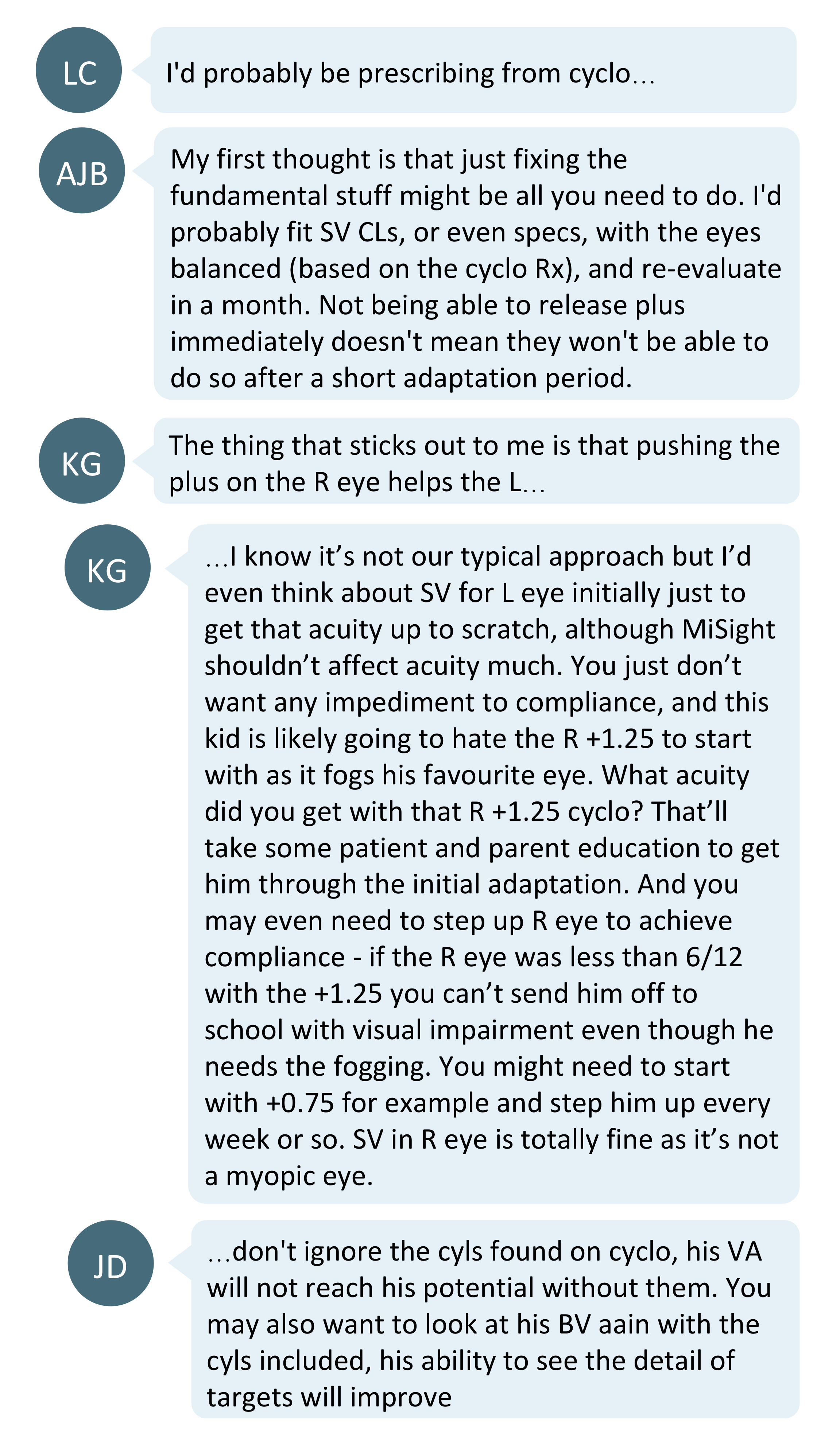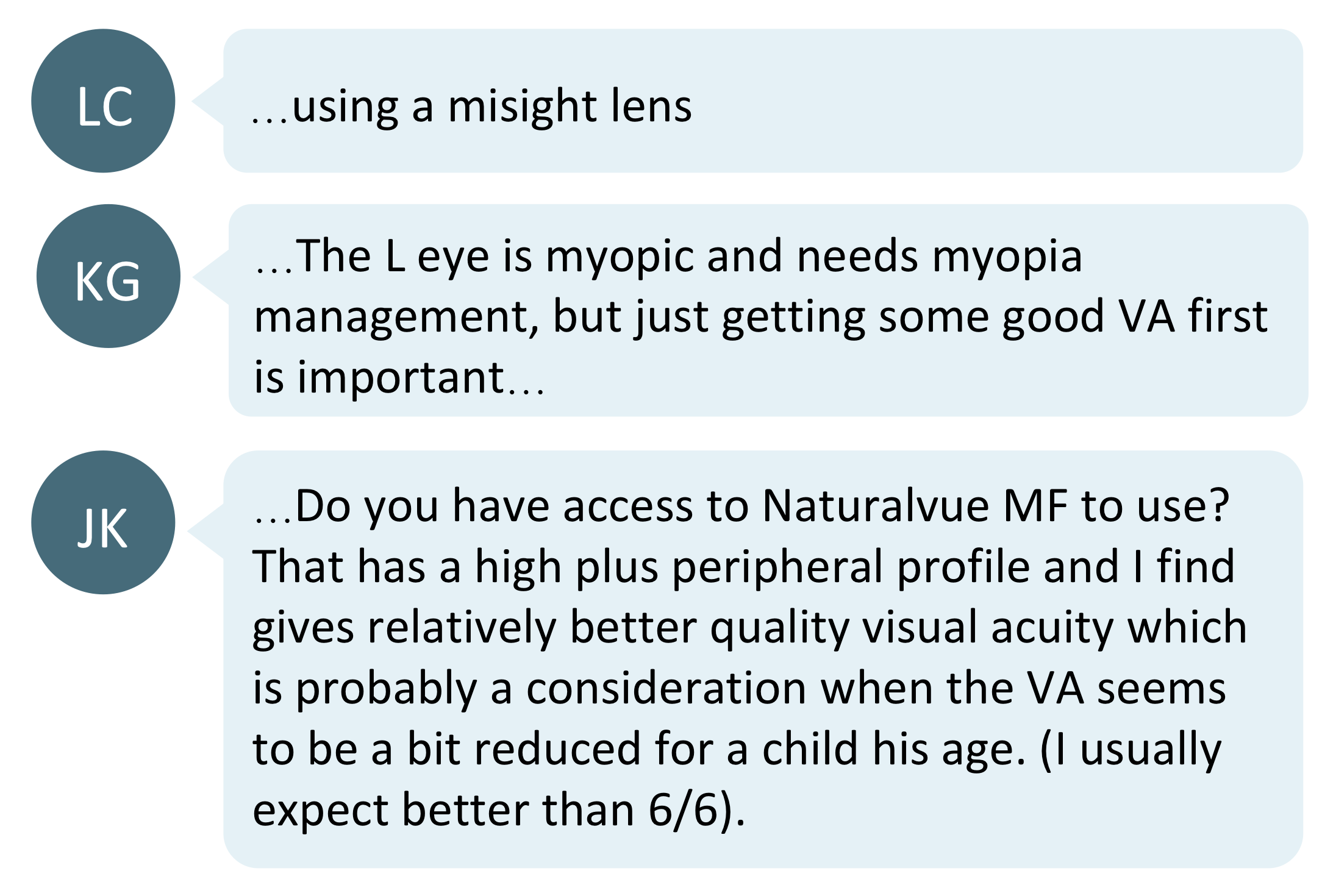Refraction can be challenging in children, and even more so in a complex presentation as for this case shared with the Myopia Profile Facebook community. It's essential to understand a child's refractive status with certainty before commencing myopia management. Is this patient a myope or not? When dealing with a complex case of pseudomyopia, antimetropia and latent hyperopia, all in one patient - how should we manage such cases? The answer involves balancing goals to manage ametropia correction, binocular vision function and myopia control.

Here is a summary of this patient's refractive findings, as provided by the managing practitioner.
| Right eye | Left eye | |
| Previous spectacles | -0.25 (6/6 or 20/20) | -1.50 (6/45 or 20/160) |
| Unaided VA | 6/7.5+2 (20/25+2) | 6/45 (20/160) |
| Auto refractor | +0.25/-0.75×22 | -3.25/-0.50×166 |
| Subjective refraction
(performed with +3.00 fog over contralateral eye) |
+0.25/-0.25×65 (6/6-1 or 20/20-1) | -2.50/-1.00×165 (6/6-1 or 20/20-1) |
| Dry retinoscopy | +0.50/-0.50×180 (6/7.5+1 or 20/25+1) | -2.00/-0.75×180 (6/21+1 or 20/80+1) |
| Cycloplegic retinoscopy | +1.25/-0.75×180 | -1.50/-0.75×180 |
Binocular Vision testing results with patient wearing RE +0.25DS LE -2.50DS (similar to subjective refraction results) were reported as follows.
| Accommodative facility | Cleared +2.00 and -2.25 flippers with reasonable speed |
| Accommodative lag | R:+2.00 L:+1.50 |
| Negative fusional reserves (base-in, divergence) | Break 12 / recovery 10 |
| Positive fusional reserves (base-out, convergence) | Break 20 / recovery 8 |
Refraction and binocular vision interaction
When the various refractive error tests give results very different from each other, it can be quite confusing. The commonality one can draw from this case is that this patient’s accommodative system is not performing normally. We can see this in the varying refractive error results and the high accommodative lag. Also, note the improvement in the myopic left eye's acuity when the eye care practitioner pushed plus in the hyperopic right eye - the L eye improved from 6/45 (20/160) with -1.50 to 6/6- (20/20-) with only an extra -1.25 best sphere on subjective refraction, when the contralateral eye was +3.00D fogged. The cycloplegic refraction, though, pointed to the L eye being only around -1.50, despite the poor acuity with glasses of this power.
The combination of the refraction and binocular vision outcomes point to accommodation and convergence insufficiency as well as accommodative spasm due to latent hyperopia in the R eye. All in all, this patient is suffering pseudomyopia and latent hyperopia in the R eye, giving additional (pseudo) myopia in the L eye, and presents with antimetropia - a subclass of anisometropia where one eye is hyperopic and the other myopic.

To address both the latent hyperopia in the R eye, which is likely causing accommodative spasm in the L (myopic) eye, managing the accommodative system was a common first management suggestion. There were a few potential ways discussed to achieve this.
- Prescribing plus at near to address the high accommodative lag.
- Fogging the R (hyperopic) eye with close-to-full correction to improve acuity in the myopic L eye with its true refraction.
- Using low-dose atropine to break the accommodative spasm. Doing this would require using a high enough dose of atropine to have the side effect of relaxing accommodation, while also managing the side effects of atropine - which takes us back to option 1!
Regardless of the means, the fact is that this child is unlikely to achieve normal acuity and comfortable binocular vision while the accommodation issues persist.
Other tests to help with refractive conundrums

When different refraction methods deliver different results, it is useful to employ other testing strategies to help 'clear the fog' (pun intended!). JK and PC’s suggestions for measuring K readings and axial length can be a good reference point to guide the clinician’s diagnostic and management decisions.
How to manage refractive error?
Now that we have a picture of diagnosis and the likely final or target refraction as indicated by cycloplegic retinoscopy, what is the best way to manage this child optically? A few questions must be addressed in the decision making process.
1. What power to prescribe?

The cycloplegic retinoscopy results are approximately 1D more hyperopic than the dry subjective refraction results. Which power should a clinician prescribe to start with?
It is useful to think of a cycloplegic result as the end point one would hope to eventually prescribe a patient, with the subjective refraction result as the starting point of that journey.
To prescribe a patient the cycloplegic result at the commencement of the management process could lead to disconcerting blur for the patient, difficult adaptation and poor compliance. Some colleagues suggested starting with the full cycloplegic refraction and hoping for swift adaptation. The success of this likely depends on what the acuity measurement was with the cycloplegic refraction, which was not reported. Some others suggested starting slightly more plus than the subjective refraction and increasing the plus from there.
2. Spectacles or contact lenses?

Some commenters favored using spectacles with an add to support the child’s accommodative system. There's more on this later in section 4 on managing binocular vision, below.
Others favored contact lenses for providing an easy, flexible way to change the prescription as the child adapts to increased plus in both eyes. Contact lenses can also help the patient better adapt to the increasingly plus prescription by being harder to remove than spectacles. Ultimately this is a balance between compliance, patient capability, cost of spectacle and/or contact lens replacement and the parent and patient preference.
3. To myopia control or not to myopia control the left eye?

The next dilemma was whether it was better to use single vision lenses first to help with improving visual acuity in the L eye - recall that it was only 6/45 or 20/160 in the presenting prescription of L -1.50 when the cycloplegic retinoscopy was only slightly more minus than this at L -1.50/-0.75x180. Alternately, should a myopia control spectacle or contact lens be used for the left eye from the start of this management plan?
Myopia controlling contact lenses (MiSight, NaturalVue and multifocal contact lenses, in the original post) were suggested as options that could strike the balance of correcting and controlling myopia, while also achieving good corrected acuity. We can establish that this child is not amblyopic as he was able to reach 6/6 at some point during the refractive testing process.
Antimetropia myopia control?
Retrospective case series research has shown that treating anisometropic patients with an orthokeratology lens for the myopic eye can significantly slow myopia progression and axial elongation in that myopic eye, without slowing the desired growth of emmetropization in a contralateral, emmetropic eye.1,2
Extrapolating this data to the current patient is interesting, as slowing the growth of the L myopic eye is desirable, but slowing growth of the R eye could lead to persistent hyperopia. The published data indicate that, at least with potential orthokeratology fitting to the L eye, this would not interfere with the emmetropization process (and hopeful reduction in hyperopia) of the R eye of this 11 year old patient.
4. What about managing binocular vision?
Before rushing to fit this child with myopia controlling contact lens for the L eye, there is an additional consideration in balancing the clinical goals of myopia correction, myopia control and binocular vision function. If the clinician wishes to provide an add at near for binocular vision support, as discussed above to manage accommodation, myopia controlling contact lenses likely won't provide this as well as a progressive addition or bifocal spectacle lens will. Various research has shown that multifocal contact lenses (MFCLs - using this terminology here to describe any lens with more than one refractive power in its design) do NOT lead to reduced accommodative lag in children and young adults as will be the case with spectacle lenses. In fact, there’s increasing evidence that MFCLs in young wearers may actually reduce the accommodative response, effectively increasing lag, and that this effect may vary across lens design.3-5
By comparison, orthokeratology (OK) appears to decrease accommodative lag slightly.6 The issue with this patient, though, is that monocular OK won't be likely support accommodation by decreasing lag in both eyes; not as consistently as a spectacle lens add - one study has shown a reduction in accommodative lag by an average of 0.39D per 1D increase in lens add power, although there is much individual variation.7
Why does managing BV matter? When the eyes have unequal accommodation demand, the eye which requires the least accommodative effort to maintain clear focus of the target will control the accommodative response in both eyes. The other eye will experience blurry images, and this retinal defocus can stimulate myopia progression.8
In the case of this patient it seems the over-accommodation of the R eye to deal with latent hyperopia has led to pseudo-myopia in the R eye and excess (pseudo) myopia in the L eye. This has led to blurred distance vision in the L eye and potentially could have contributed to additional myopia progression. Hence, addressing the binocular vision issues is key to the overall patient management and L eye myopia management strategy.
Take home messages:
- When refracting complex cases such as this, the cycloplegic retinoscopy result provides the end point or goal refraction, but the starting point may be more likely the subjective refraction. Fogging the contralateral eye for subjective refraction helped to improve acuity.
- In cases where one might want to slowly change a prescription over time, contact lenses are a good option, but in this case management of the binocular vision disorders may lend themselves more to spectacle correction - primarily by providing a stronger 'add' effect at near.
- The interaction between binocular vision function, refraction and acuity is highly important in firstly determining the management strategy and secondly managing refractive changes over time - this being myopia management for one eye and potential emmetropization for the other eye.
- In complex cases like these, the discussion and suggestions by colleagues above shows that there's no one 'correct' way to proceed, and numerous good ways to start. There is a balance to be struck between managing binocular vision, ametropia correction and myopia control with the ultimate goals of achieving comfortable vision for the patient in the short term, and reducing the eye health risk of myopia progression in the longer term.

About Kimberley
Kimberley Ngu is a clinical optometrist from Perth, Australia, with experience in patient education programs, having practiced in both Australia and Singapore.

About Connie
Connie Gan is a clinical optometrist from Kedah, Malaysia, who provides comprehensive vision care for children and runs the myopia management service in her clinical practice.
This content is brought to you thanks to an unrestricted educational grant from
![]()
References:
- Cheung SW, Cho P, Fan D. Asymmetrical increase in axial length in the two eyes of a monocular orthokeratology patient. Optom Vis Sci. 2004;81(9):653-665. (link)
- Tsai WS, Wang JH, Lee YC, Chiu CJ. Assessing the change of anisometropia in unilateral myopic children receiving monocular orthokeratology treatment. J Formosan Med Assoc. 2019;118(7):1122-1128.(link)
- Gong CR, Troilo D, Richdale K. Accommodation and Phoria in Children Wearing Multifocal Contact Lenses. Optom Vis Sci. 2017;94(3):353-60. (link)
- Kang P, Wildsoet CF. Acute and short-term changes in visual function with multifocal soft contact lens wear in young adults. Cont Lens Anterior Eye. 2016;39(2):133-40. (link)
- Gifford KL, Schmid KL, Collins J, Maher C, Makan R, Nguyen TKP, et al. Accommodative responses of young adult myopes wearing multifocal contact lenses. Invest Ophthalmol Vis Sci. 2019;60(9):6376. (link)
- Gifford KL, Gifford P, Hendicott PL & Schmid KL. Zone of Clear Single Binocular Vision in Myopic Orthokeratology. Eye Contact Lens 2020;46:82-90. (link)
- Cheng D, Schmid KL, Woo GC. The effect of positive‐lens addition and base‐in prism on accommodation accuracy and near horizontal phoria in Chinese myopic children. Ophthalmic Physiol Opt 2008;28:225-237. (link)
- Charman WN. Aniso‐accommodation as a possible factor in myopia development. Ophthalmic Physiol Opt. 2004;24(5):471-479. (link)











